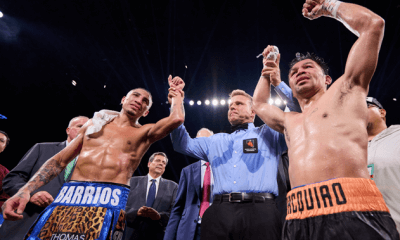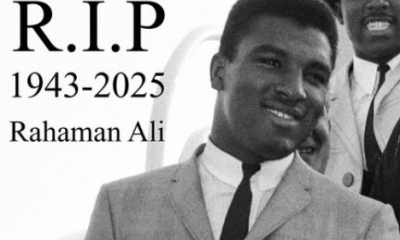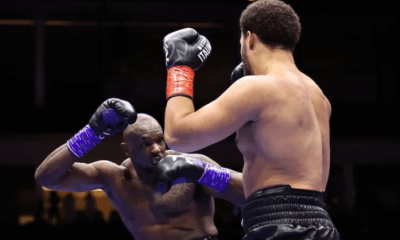Articles of 2005
Max Baer Whipped by Unknown
Who was the Cinderella Man who handed Max Baer a stunning defeat in the ring 69 years ago this month?
It wasn't James J. Braddock. His upset victory over Baer for the heavyweight championship of the world occurred in New York City on June 14, 1935.
But almost 16 months later, Baer – fighting in his 73rd bout for pay – lost a decision to an opponent who'd never even had a single professional match before.
At least that's what the Ring Record Book, BoxRec.com and various other sources say happened in Platteville, Wisconsin on October 8, 1936.
But other sources differ. In the record for Baer published in The Boxing Record Book issued by Fight Fax, Inc., for instance, he is credited with a decision victory in Platteville over a whole different opponent than the one to whom the above named sources say he lost.
Thanks to conflicting newspaper accounts and missing pieces of the puzzle, what really happened when Max Baer brought his traveling sideshow to the community of less than 10,000 residents about 70 miles southwest of Madison, the state capital, is likely to forever remain another head-scratching episode in the life and times of the king who preferred to be court jester.
After losing the title to Braddock and getting knocked out by Joe Louis in three rounds three months later, Baer decided there were better ways to stay in the spotlight he craved than getting hit in the head. They were typically bizarre. For a while he waved a baton in front of a radio jazz band. Then, on January 13, 1936, Baer announced that he was going to become a professional wrestler. “No fighter has ever won the wrestling crown and if I'm good enough I hope to challenge for the title,” he told Braven Dyer of the L.A. Times. “I am definitely through with the fight game. This wrestling business looks good to me, because I can keep at it and probably do some additional work in motion pictures.”
But the fact is that despite his good reviews in the mildly successful 1933 theatrical release, “The Prizefighter and the Lady,” Hollywood had doubts about the handsome but goofy Baer. Metro-Goldwyn-Mayer Studios announced less than a week after Baer took the championship from Primo Carnera on June 15, 1934, that it wasn't renewing its option on the new champion. “The reason given was that Baer might prove only a flash, with no outstanding film star qualities,” reported the Associated Press.
The rasslin' deal fizzled, too, and on February 17, 1936 the Livermore Larruper announced that he was preparing to start larruping again.
“I'll be ready to fight again inside of three months,” said Baer. “I've quit the bright lights once and for all. I haven't touched a drink in two weeks. I've reduced cigarettes to two a day. I've done a lot of roadwork and walking. My big problem is the hands. That's what licked me in fights with Braddock and Louis – that and the playboy stuff.”
According to Baer's manager, Ancil Hoffman, there were megabucks offers from London to fight British champion Jack Peterson, and Amsterdam wanted him against Germany's Walter Neusel. And naturally Baer was ready to take his title back anytime Braddock wanted to get in the ring with him again, Hoffman said.
But when the grand comeback tour finally kicked off, it wasn't in Europe or even New York or Los Angeles, and the guy in the other corner in Salt Lake City on June 15, 1936 wasn't Peterson, Neusel or any other contender. But although floored five times, unknown Tony Souza was still standing at the final bell. Max got the decision, but according to the Associated Press, he “displayed little to warrant consideration among the present crop of heavyweights.”
Two days later in Boise, Idaho, Baer knocked out another unknown, Bob Frazier, and by the end of the month he had beaten three more nonentities in Pocatello, Idaho, Tyler and San Antonio, Texas, respectively. But the parade through palookadom wasn't getting any raves. After Baer knocked out local hero Wilson Dunn in San Antonio on June 24, he needed a police escort to get out of the arena because the crowd didn't cotton to his clowning tactics.
July brought five more wins against five more nondescript foes, and in August Baer toured the Pacific Northwest, padding his record and bank account at the expense of local fighters of absolutely no repute. With him were Hoffman and Max's younger brother, Buddy, who was following in his footsteps as a boxer.
The Baers sometimes took turns beating the same guys (and laying down bets with Hoffman about who could do it faster). Two days after Buddy decisioned somebody named Don Baxter on the undercard of Max's win over Al Frankco in Lewiston, Idaho, Max knocked Baxter out in one round in Coeur d'Alene.
By September, when the Baer brigade rolled into the Midwest, the Missouri boxing commission said no thanks when Max offered to grace rings in Joplin and Springfield.
“We permitted Baer to present his clowning act when he was champion,” said Chairman Garrett L. Smalley. “It's different now and we do not intend to let a has-been fighter come into this state with a build-up racket simply to make money.”
Illinois passed, too, even after the former champion announced that he would be mixing boxing and politics by campaigning for the reelection of President Franklin D. Roosevelt at every stop along his comeback tour.
On October 6 in Evansville, Indiana, Max stopped Tim Charles in four, and Buddy collected a $10 bet from Hoffman after flattening Babe Davis in two rounds on the undercard, improving on Max's six-round decision over Davis in Keokuk, Iowa the week before.
Then, with 23 comeback wins under his belt, it was on to Wisconsin for the man the Platteville Journal called “one of the greatest heavyweights since Jack Dempsey.” The October 7, 1936 front page story announcing Baer's scheduled six-round bout against Willie Davis of Chicago at the local fairgrounds the next day and identified Davis as a “colored fistic flash” whose main claim to fame was getting knocked out by Joe Louis several months earlier. The Journal credited Davis with a recent win over someone named Tiny Bittner, but according to the ring record for Davis available at boxrec.com, Davis had not won any of his previous nine pro fights.
A separate large advertisement in The Journal announced that in the semi-windup of the card at the local fairgrounds, Buddy Baer would meet Arthur Oliver, an African-American from Chicago who had represented the USA as a heavyweight the previous August in the 1936 Olympics in Berlin, Germany.
Oliver had lost his first Olympic match. Also that year's National Golden Gloves heavyweight champion, he was making his professional debut on the card that included four other preliminary bouts.
The promoter of record was Leo M. Kane American Legion Post No. 42, which invited the public to meet the Baer brothers at “big open party” at Legion Hall after the fights.
Whether the former heavyweight champion was in a party mood afterwards depends on which newspaper report of what happened in the ring can be believed.
Relying on reports from “special correspondents,” dailies in Madison and Milwaukee proclaimed on October 9 that Willie Davis had survived a third-round knockdown to win a decision over Baer. That result was subsequently reported in the December 1936 issue of The Ring magazine, albeit without fanfare:
“Max Baer continued his successful tour of the tank towns by scoring KOs over Sammy Evans in three heats, Tim Charles in four rounds, and winning a six-round decision over Bearcat Wright, but then was whipped by an unknown, Willie Davis, in a six round contest.”
But that was diametrically opposite of the day-after-the-fight report in the Dubuque (Iowa) Telegraph Herald, which stated that Baer, “clowning through his scheduled six-round setto with Willie Davis, knocked down the latter for the count in the third round.”
And, added the Telegraph Herald account, “when Baer’s hand was lifted the crowd cheered as they felt it was a spirited tiff. One ringsider stood up and bellowed so that all could hear: ‘The colored boy is plenty good.’
“Maxie cracked right back: ‘He should be. He is my sparring partner.’”
All the initial newspaper reports agreed about one thing: that Buddy Baer knocked out Art Oliver in the fourth round of their Platteville bout.
But then, on October 12, the Dubuque newspaper did an abrupt one-eighty, reporting that Max Baer “is held by countless fans who saw last Thursday’s boxing exhibition to have lost the decision.”
And not to Willie Davis, but rather to Art Oliver.
“Although Baer’s opponent was announced as Willie Davis, the principal was in reality Oliver,” announced the Telegraph Herald story, which noted that the former Olympian “kept flicking out a right that really bothered the ex-world’s heavyweight boxing champion.”
“As the bout was a 'show' no recognized judges were assigned to pick the winner,” continued the account, “but his negro foe, Art Oliver, gave Baer a workout for his cut in the profits in the Platteville show.”
The files of the Wisconsin Athletic Commission, which oversaw boxing in the state from 1913 until it was phased out of existence in 1980, shed no light on the matter. No results for the Platteville card are contained in the minutes of the commission’s meetings. While Max and Buddy Baer were both duly licensed to fight on the card, there are no license applications for Davis and Oliver in the commission files.
Interestingly, Max Baer’s license application lists Lou Gross of Chicago as a reference behind former heavyweight champs Jack Dempsey and Jess Willard. In the minutes of the commission’s November 9 meeting, Gross – who was suspended along with the Chicago boxers for not taking out a Wisconsin license – is identified as the handler of Davis and Oliver.
In any case, the Platteville fight did not warrant banner headlines throughout the country. More newspaper ink was devoted the following week to what happened in Boston when Max refereed a wrestling card in Boston and “knocked out” a couple bad guys.
That same night in South Bend, Indiana, rising title contender Joe Louis flattened Willie Davis in a three-round exhibition bout. Or at least somebody calling himself Willie Davis.
“A protest from Lou Gross of Chicago, who said he manages Davis and that Davis did not appear against Louis, brought an investigation which sportswriters said showed an illegible scrawled signature on the athletic commission's permit for the exhibition,” the Associated Press reported on October 16. “The writers said from the signature, supposed to be that of the boxer who met Louis, they were unable to determine his identity.”
But everybody knew the mugging, preening showboat who knocked out Dutch Weimer in two rounds with what was described as “a light tap on the ribs” on October 20 in Toronto. After no less than Provincial Premier Mitchell F. Hepburn called it a “fake, fiasco and disgrace to sport,” Max Baer said he was homesick and went back to California,
He would eventually get serious enough to again appear in boxing's top arenas and rankings. Buddy Baer would twice lose to Joe Louis in championship fights.
Willie Davis returned to the total anonymity whence he came. While Art Oliver was generally acknowledged as the winner in his first pro fight over a former heavyweight champion of the world, his fairytale upset didn't carry him very far. After winning a few more bouts, Oliver lost eight in a row, and in 1944 he was killed when a train crashed into his car near Hammond, Indiana.
-

 Featured Articles3 weeks ago
Featured Articles3 weeks agoThe Hauser Report: Zayas-Garcia, Pacquiao, Usyk, and the NYSAC
-

 Featured Articles2 weeks ago
Featured Articles2 weeks agoOscar Duarte and Regis Prograis Prevail on an Action-Packed Fight Card in Chicago
-

 Featured Articles2 weeks ago
Featured Articles2 weeks agoThe Hauser Report: Cinematic and Literary Notes
-

 Book Review1 week ago
Book Review1 week agoMark Kriegel’s New Book About Mike Tyson is a Must-Read
-

 Featured Articles4 weeks ago
Featured Articles4 weeks agoArne’s Almanac: Pacquiao-Barrios Redux
-

 Featured Articles3 weeks ago
Featured Articles3 weeks agoRemembering Dwight Muhammad Qawi (1953-2025) and his Triumphant Return to Prison
-

 Featured Articles2 weeks ago
Featured Articles2 weeks agoRahaman Ali (1943-2025)
-

 Featured Articles3 days ago
Featured Articles3 days agoMoses Itauma Continues his Rapid Rise; Steamrolls Dillian Whyte in Riyadh













